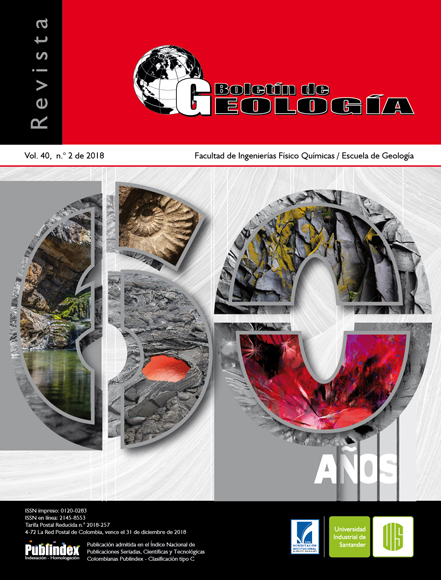Analysis of sliding block models for prediction of the dynamic behavior of the mass removal phenomenon: One-parameter Model and Two-parameter Model
Published 2018-06-05
Keywords
- Landslide,
- turbulence parameter,
- friction,
- power line,
- pore pressure coeffiient
How to Cite
Altmetrics
Abstract
This study aims to show the variations, from a conceptual perspective, between two sliding block models. The evaluation of these two models allows to determine the kinematic variables (range, velocity and acceleration) of a sliding mass. Herein, is assessed how the outcomes of these models are affected by varying the parameters of the friction angle (φ), turbulence (ξ), and pore pressure coeffiient (ru). To achieve this, the equations of motion are solved through analytical and numerical techniques assuming that, for an isotropic material, the motion is one dimensional and function of the independent variables. Finally, a comparison between the velocities obtained with each model is presented, and a concluding remarks section in which the practical use of each solution in the avalanche dynamics problem is argued.
Downloads
References
Campos, A., Holm-Nielsen, N., Díaz, C., Rubiano, D., Costa, C., Ramírez, F., y Dickson, E. (2012). Análisis de la gestión del riesgo de desastres en Colombia: un aporte para la construcción de políticas públicas. Bogotá, Colombia: Banco Mundial.
Dai, F.C., Lee, C.F., and Ngai, Y.Y. (2002). Landslide risk assessment and management: an overview. Engineering Geology, 64(1), 65-87. doi: 10.1016/S0013-7952(01)00093-X.
Finlay, P.J., Mostyn, G.R., and Fell, R. (1999). Landslide risk assessment: prediction of travel distance. Canadian Geotechnical Journal, 36(3), 556-562. doi: 10.1139/t99-012.
Heim, A. (1932). Bergsturz und Menschenleben. Der Naturforschenden Gesellschaft in Zürich.
Hungr, O. (1995). A model for the runout analysis of rapid flw slides, debris flws, and avalanches. Canadian Geotechnical Journal, 32(4), 610-623. doi: 10.1139/t95-063.
Hungr, O., Corominas, J., and Eberhardt, E. (2005). Estimating landslide motion mechanism, travel distance and velocity. In: O. Hungr, R. Fell, R. Couture, and E. Eberhardt (Eds.). Landslide risk management (pp. 99-128). London: Taylor and Francis Group.
Hungr, O., and Evans, S.G. (2004). Entrainment of debris in rock avalanches: An analysis of a long run-out mechanism. GSA Bulletin, 116(9-10), 1240-1252. doi: 10.1130/B25362.1.
Hutchinson, J.N. (1988). Morphological and geotechnical parameters of landslides in relation to geology and hydrogeology. 5th International Symposium on Landslides. Lausanne, Switzerland.
Körner, H.J. (1976). Reichweite und Geschwindigkeit von Bergstürzen und Fließschneelawinen. Rock Mechanics, 8(4), 225-256.
Mancarella, D., and Hungr, O. (2010). Analysis of run-up of granular avalanches against steep, adverse slopes and protective barriers. Canadian Geotechnical Journal, 47(8), 827-841. doi: https://doi.org/10.1139/T09-143.
McDougall, S., and Hungr, O. (2005). Dynamic modelling of entrainment in rapid landslides. Canadian Geotechnical Journal, 42(5), 1437-1448. doi: 10.1139/t05-064.
Perla, R., Cheng, T.T., and McClung, D.M. (1980). A two-parameter model of snow-avalanche motion. Journal of Glaciology, 26(94), 197-207. doi: 10.3189/S002214300001073X.
Pirulli, M. (2005). Numerical modelling of Landslide runout. PhD Thesis. Politecnico Di Torino, Italy.
Román, D.C., y Ruiz, I.T. (2015). Modelamiento del fenómeno de remoción de masas mediante la implementación de un modelo de deslizamiento en bloque. Tesis. Universidad Industrial de Santander, Colombia.
Salm, B. (1968). On nonuniform, steady flw of avalanching snow. Bern, Switzerland: IUGG/IAHS General Assembly.
Sassa, K. (1988). Geotechnical model for the motion of landslides. 5th International Symposium on Landslides. Lausanne, Switzerland.
Voellmy, A. (1955). Über die Zerstörungskraft von Lawinen. Schweizerische Bauzeitung, 73(12), 159-165.
Yue, Z. (2014). Dynamics of large and rapid landslides with long travel distances under dense gas expanding power. In: K. Sassa, P. Canuti, and Y. Yin (Eds.). Landslide science for a safer geoenvironment (pp. 233-240). Vol. 3. Switzerland: Springer International Publishing. doi: 10.1007/978-3-319-04996-0_36.
Zhao, T. (2014). Investigation of Landslide-Induced Debris Flows by the DEM and CFD. PhD. Thesis, University of Oxford, UK.

